
SIAM JOURNAL ON CONTROL AND OPTIMIZATION
Scope & Guideline
Pioneering Research in Applied Mathematics and Control Systems
Introduction
Aims and Scopes
- Optimal Control Theory:
Research in this area explores the mathematical optimization of control systems, including both linear and nonlinear dynamics, and the development of efficient algorithms for solving optimal control problems. - Stochastic Control Systems:
The journal publishes studies on systems affected by randomness, including stochastic optimal control, stochastic differential equations, and applications in finance and economics. - Game Theory and Control:
This scope includes the analysis of competitive scenarios where multiple agents interact, focusing on Nash equilibria, Stackelberg strategies, and mean-field games. - Distributed Control and Consensus:
Research on multi-agent systems, where coordination and consensus among distributed agents are fundamental, including applications in networked systems and social dynamics. - Time-Delay Systems:
Studies focused on systems with delays in feedback or control inputs, exploring stability, control strategies, and optimization techniques suitable for these systems. - Nonlinear Dynamics and Control:
This area investigates the complexities of nonlinear systems, including analysis and control methodologies tailored for chaotic or highly nonlinear behaviors. - Numerical Methods in Control:
The development and analysis of numerical algorithms for solving control problems, including finite element methods, approximation techniques, and computational efficiency.
Trending and Emerging
- Machine Learning and Control:
There is a growing trend towards integrating machine learning techniques with control systems, focusing on data-driven methods for optimizing control strategies and enhancing system performance. - Mean-Field Games and Control:
Research on mean-field games has gained momentum, addressing large populations of interacting agents and their collective dynamics, which is relevant in various applications such as economics and social sciences. - Robust and Adaptive Control:
An increasing emphasis on robust and adaptive control strategies reflects the need to handle uncertainties and variations in system dynamics, particularly in real-world applications. - Networked and Distributed Control Systems:
The study of control systems over networks, including issues related to communication delays, distributed algorithms, and consensus protocols, is rapidly gaining importance. - Optimal Control under Uncertainty:
Research is increasingly focusing on optimal control problems that incorporate uncertainties, such as stochastic control and risk-sensitive optimization, which are vital for applications in finance and engineering.
Declining or Waning
- Classical Control Techniques:
While foundational, classical control methods such as PID control and linear feedback have seen less emphasis as newer, more sophisticated methodologies like robust and adaptive control gain traction. - Static Optimization Problems:
There appears to be a decreasing trend in research focused solely on static optimization problems, with a shift towards dynamic and time-variant optimization frameworks that reflect real-world complexities. - Single-Agent Control Models:
Research focusing exclusively on single-agent control systems is becoming less prevalent, as the community moves towards more intricate models involving multi-agent interactions and game-theoretic approaches. - Deterministic Models in Stochastic Contexts:
The integration of deterministic models in contexts that are inherently stochastic is declining, as the need for frameworks that address uncertainty directly is increasingly recognized.
Similar Journals
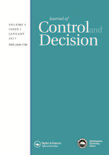
Journal of Control and Decision
Empowering Knowledge Sharing in Technological AdvancementsJournal of Control and Decision, published by Taylor & Francis Ltd, is a premier academic journal that serves as a vital resource in the interdisciplinary fields of control systems, artificial intelligence, optimization, and human-computer interaction. Established in 2014 and converging into its upcoming decade, the journal emphasizes rigorous research and practical applications, contributing significantly to both academic discourse and technological advancements. With an impressive categorization in various quartiles, notably Q2 in Control and Systems Engineering and Q3 in several other categories, the journal showcases high-quality contributions that enhance our understanding of complex decision-making processes. Although it currently does not offer open access options, the journal is committed to maintaining impactful scholarly communication, securing its position in Scopus rankings across multiple disciplines. Researchers, practitioners, and students are encouraged to engage with its rich content to foster innovation and knowledge sharing in these dynamic fields.

JOURNAL OF DYNAMICAL AND CONTROL SYSTEMS
Pioneering Research in Control Systems and Numerical AnalysisJOURNAL OF DYNAMICAL AND CONTROL SYSTEMS is a premier interdisciplinary journal published by Springer/Plenum Publishers, recognized for its significant contributions to the fields of dynamical systems, control theory, and numerical analysis. With an ISSN of 1079-2724 and an E-ISSN of 1573-8698, the journal serves as an important platform for researchers and professionals to share their findings and innovative methodologies. Covering topics from algebra and number theory to control and optimization, it holds a respectable position in the 2023 Q2 quartile rankings across various categories, reflecting its impact and quality within the academic community. The journal’s scope is expansive, aiming to foster advancements and insights that are instrumental for academics and industry experts alike. With a convergence period from 1995 to 2024, the journal continues to be a vital resource for students, researchers, and professionals seeking to navigate the complexities of control systems and their dynamic interactions. For those looking to contribute to the ongoing discourse in these critical areas of study, the JOURNAL OF DYNAMICAL AND CONTROL SYSTEMS remains a highly recommended choice.

Minimax Theory and its Applications
Charting New Territories in Mathematical AnalysisMinimax Theory and its Applications is an esteemed academic journal published by HELDERMANN VERLAG, focusing on the intricate domains of mathematics, particularly in the fields of analysis, computational mathematics, and control and optimization. With its ISSN 2199-1413 and E-ISSN 2199-1421, the journal has established a reputable platform for disseminating high-quality research that engages with minimax principles and their multifaceted applications in contemporary mathematical challenges. The journal has made significant strides since its inception in 2016, currently ranked Q3 in several relevant categories as of 2023. These rankings underscore its growing contribution to the academic community, attracting researchers and professionals seeking to expand their knowledge and application of minimax theory. Although it does not currently provide open access options, the rigorous peer-review process ensures that the included works meet the highest scholarly standards, bolstering the journal's overall impact within the field. Based in Germany, the journal continues to foster international discourse and collaboration among mathematicians and applied theorists alike.
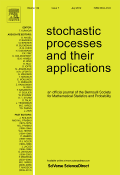
STOCHASTIC PROCESSES AND THEIR APPLICATIONS
Pioneering Insights in Applied Mathematics and SimulationSTOCHASTIC PROCESSES AND THEIR APPLICATIONS, published by Elsevier, is a leading journal in the realms of Applied Mathematics, Modeling and Simulation, and Statistics and Probability. Established in 1973 and continually evolving with the latest research trends, this journal has secured its place in the Q1 category across multiple disciplines, reflecting its influence and prestige in the academic community. With a Scopus Rank of #90 in Statistics and Probability and notable rankings in Applied Mathematics and Modeling and Simulation, it serves as a crucial platform for disseminating cutting-edge research findings and applications of stochastic processes. Although it operates under a traditional access model, its comprehensive scope encourages submissions from a diverse range of topics that push the boundaries of knowledge in probability theory and its practical applications. Researchers, professionals, and students are invited to contribute original research, reviews, and case studies that can propel the field into new territories, further solidifying the journal's role as an essential resource for advancing understanding in stochastic processes.
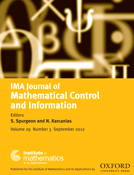
IMA JOURNAL OF MATHEMATICAL CONTROL AND INFORMATION
Driving Progress in Mathematical Control Since 1984.IMA Journal of Mathematical Control and Information, published by Oxford University Press, is a prestigious journal dedicated to advancing the fields of mathematical control, optimization, and information theory. Since its inception in 1984, it has been a vital resource for researchers and professionals, providing a platform for high-quality scholarly articles that explore innovative methodologies and theoretical advancements. With an impressive Q2 ranking in categories such as Applied Mathematics and Control Systems Engineering, the journal is recognized for its rigorous peer-review process and significant contributions to mathematics and engineering. While it does not currently offer Open Access options, its impact is reflected in its notable Scopus rankings, including a rank of #47 in Control and Optimization. As it continues to converge into 2024, the IMA Journal remains a cornerstone for academics and practitioners seeking to deepen their understanding and application of mathematical concepts in control and information systems.
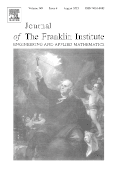
JOURNAL OF THE FRANKLIN INSTITUTE-ENGINEERING AND APPLIED MATHEMATICS
Fostering a legacy of excellence in academic research.JOURNAL OF THE FRANKLIN INSTITUTE-ENGINEERING AND APPLIED MATHEMATICS, published by Pergamon-Elsevier Science Ltd, stands as a premier platform for disseminating cutting-edge research in the fields of applied mathematics, computer networks and communications, control and systems engineering, and signal processing. Established in 1826, this esteemed journal carries a rich heritage of scholarly contributions and continues to be influential, evident in its 2023 recognition as a Q1 journal across multiple research categories. With its commitment to advancing knowledge and innovation, the journal invites researchers, professionals, and students to engage with a diverse array of rigorous studies designed to push the boundaries of engineering and applied mathematics. Although open access options are currently unavailable, the journal maintains a robust publication standard, ensuring that each article undergoes a meticulous peer-review process. By contributing to the JOURNAL OF THE FRANKLIN INSTITUTE, authors can enhance their visibility and impact within the global academic community, solidifying the journal’s role as a cornerstone of research and development.
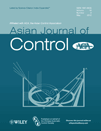
ASIAN JOURNAL OF CONTROL
Elevating Standards in Control and Systems ResearchWelcome to the Asian Journal of Control, an esteemed publication in the fields of Control and Systems Engineering as well as Electrical and Electronic Engineering, published by WILEY. With a continuous convergence from 2000 to 2024, this journal serves as a vital platform for researchers, professionals, and students, offering high-quality peer-reviewed articles that drive innovation and advancement in various control strategies and systems. The journal is renowned for its rigorous academic standards, reflected in its impressive Scopus rankings, with a percentile of 90th in Mathematics (miscellaneous) and 67th in Engineering Control and Systems. Although it does not currently offer open access, the Asian Journal of Control remains an indispensable resource for those looking to push the boundaries of knowledge in engineering disciplines. With its Q2 category ranking in both relevant fields, the journal is poised to influence future research and applications, making it a must-read for those invested in the evolving landscape of control technologies.
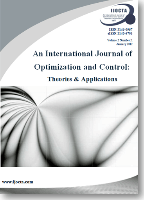
International Journal of Optimization and Control-Theories & Applications-IJOCTA
Connecting Scholars to the Future of Applied Mathematics.International Journal of Optimization and Control-Theories & Applications (IJOCTA), published by Ramazan Yaman, stands as a pivotal platform in the fields of applied mathematics and control optimization. With an ISSN of 2146-0957 and an E-ISSN of 2146-5703, IJOCTA has embraced an Open Access model since 2011, ensuring that its scholarly contributions are widely accessible to researchers, professionals, and students alike. Based in Turkey at the Istanbul Atlas University, the journal is committed to advancing the scope of optimization and control theories, featuring comprehensive studies that bridge theoretical foundations with practical applications. Despite its relatively recent surge, IJOCTA has achieved impressive standings, including a Q3 quartile ranking in both Applied Mathematics and Control and Optimization for 2023, alongside commendable Scopus rankings (Rank #192 in Applied Mathematics and Rank #44 in Control and Optimization). These metrics underscore the journal’s growing significance and impact within the global research community, making it an invaluable resource for those seeking to explore contemporary developments in optimization and control.

AUTOMATION AND REMOTE CONTROL
Pioneering Research in Control and Systems EngineeringAUTOMATION AND REMOTE CONTROL, published by MAIK Nauka/Interperiodica/Springer, is a distinguished international journal renowned for its contribution to the fields of Control and Systems Engineering and Electrical and Electronic Engineering. With an ISSN of 0005-1179 and an E-ISSN of 1608-3032, this journal has been pivotal since its inception in 1973, offering valuable insights and innovative research findings that span the spectrum of automation technologies and control systems. While categorized in the Q3 quartile in both relevant engineering categories as of 2023, it holds a significant position for researchers aiming to disseminate and access quality research in these areas. The journal emphasizes the importance of integrating advanced automation methods and control strategies, fostering the exchange of knowledge among academics, industry professionals, and students alike. Although it does not provide open access options, the compelling research presented within its pages continues to influence the ongoing development of automation systems worldwide.

Nonlinear Analysis-Hybrid Systems
Charting New Territories in Hybrid System ApplicationsNonlinear Analysis-Hybrid Systems is a premier academic journal published by ELSEVIER SCI LTD, dedicated to exploring the intricacies of nonlinear analysis and its applications in hybrid systems. With a significant emphasis on interdisciplinary research, this esteemed journal serves as a comprehensive forum for innovative studies, bridging the fields of mathematics, computer science, and engineering. As evidenced by its remarkable 2023 impact factor and esteemed ranking in the Q1 category across various disciplines—including Analysis (Ranked #2/193), Control and Systems Engineering (Ranked #52/321), and Computer Science Applications (Ranked #149/817)—the journal consistently publishes high-quality research that contributes to advancements in theory and practical implementations. Although it operates under a traditional access model, researchers and practitioners benefit from access to cutting-edge research that shapes modern methodologies and technological progress. Nonlinear Analysis-Hybrid Systems not only highlights the growing significance of hybrid systems but also aims to foster collaboration among researchers and professionals, thereby impacting multiple domains through its rigorous publication standards.